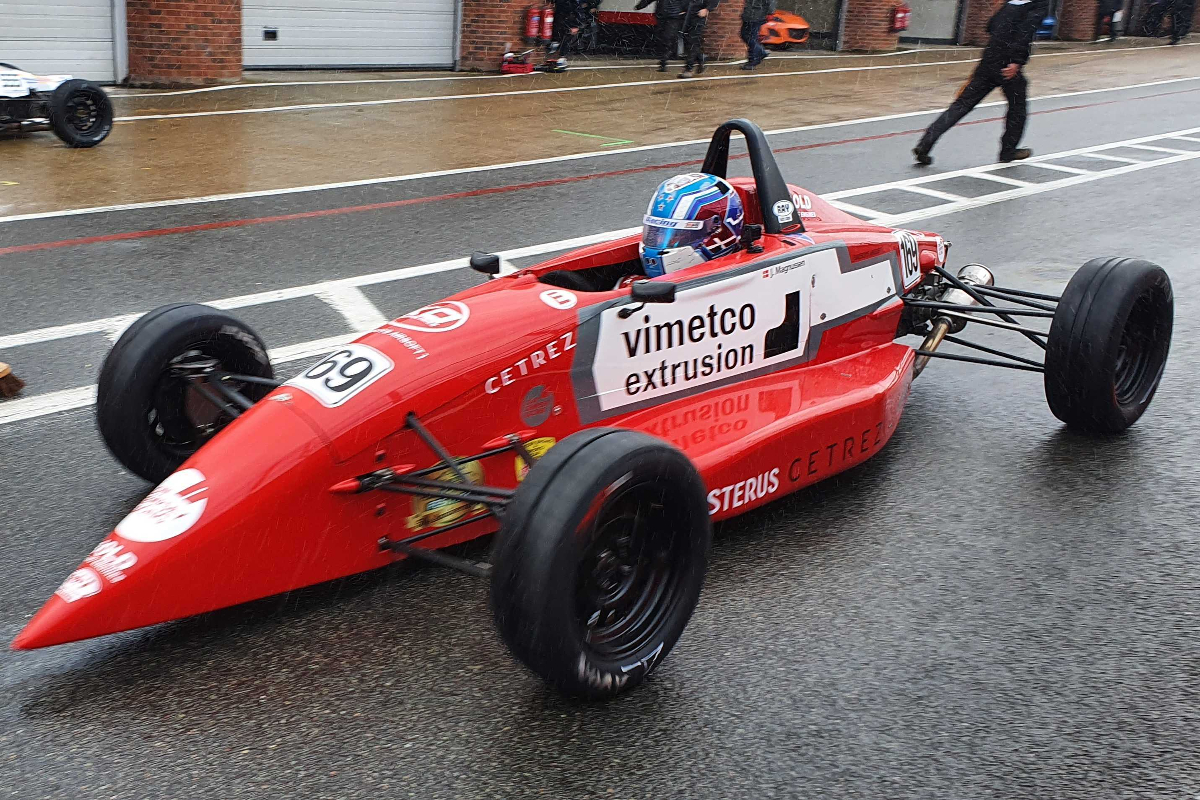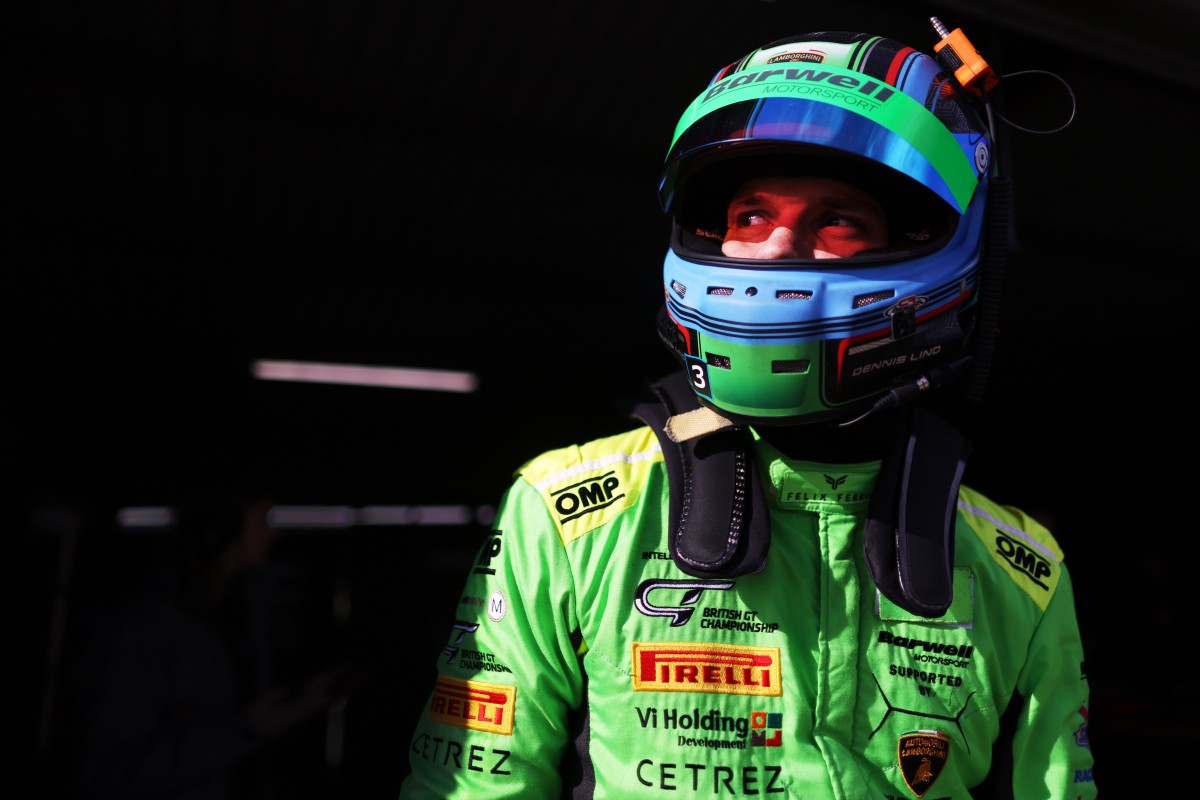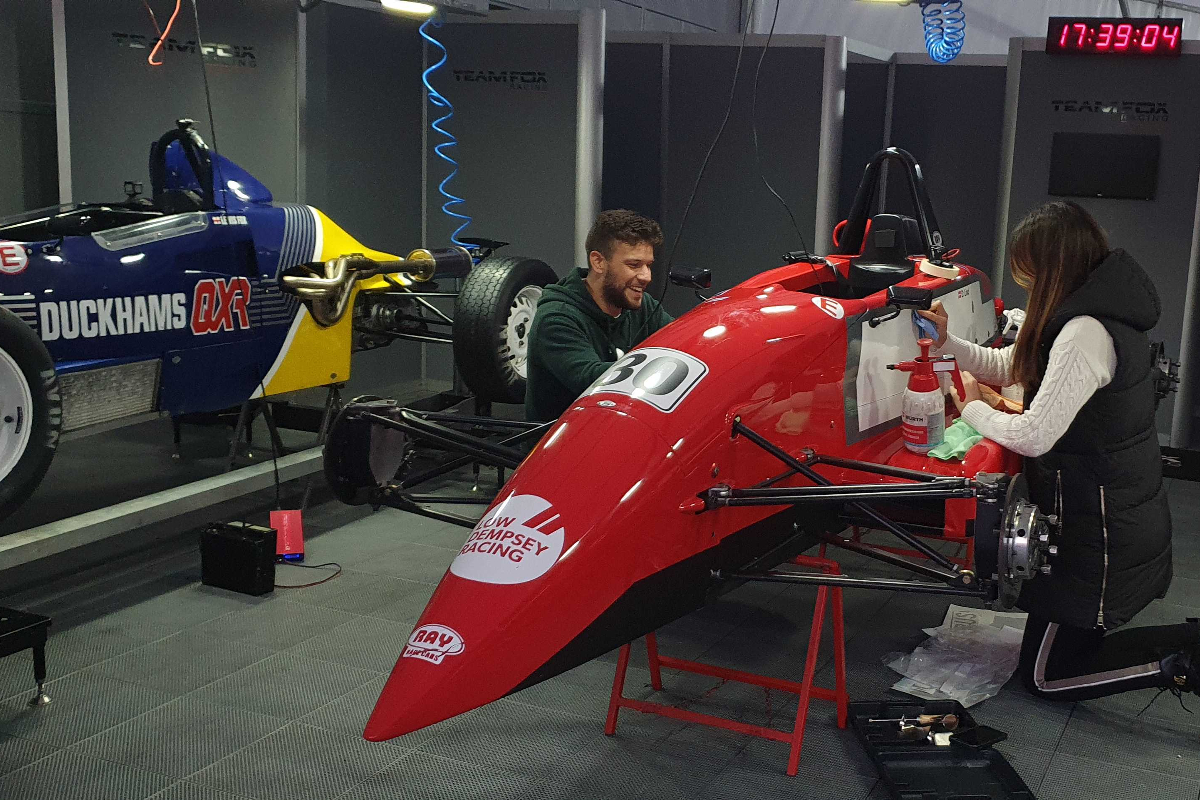
Photos: Ida Wood
Jan Magnussen and his nephew Dennis Lind are two of Denmark’s highest profile professional drivers, and both recently returned to their roots in the Formula Ford Festival. Formula Scout was there to see how it went
When asked why they’re at a wet Brands Hatch on a Friday afternoon and how they’re finding their time there, both Dennis Lind and Kevin Magnussen say ‘fun’.
While that’s true, the Friday in question was the final day of pre-event testing for the Formula Ford Festival on the Indy layout two weeks ago and it was being treated as seriously by the two Danes as any professional commitment.
New British GT champion Lind was first to explain his attendance, while his uncle Magnussen was immersed in watching onboards of his Low Dempsey Racing team-mates as he sought set-up changes as Brands changed from dry to wet and back.
“I got approached by [FF1600 racer and BRSCC chairman] Peter Daly who actually is the race director in British GT and he asked me if I was doing the Festival, and the initial answer was no,” said Lind, who won the Festival in 2010.
“And then after I won the British GT title he came back and he said: should we try and do it? Because then we’ll pay the entry fee and help a little bit in that direction, and I said ‘OK, let’s try to work with it’, and a few emails back and forward and Low Dempsey Racing came up and gave a good offer. Then I called Jan and said ‘hey, do you want to do the Festival’ and he was like ‘I’m in’, and that was how it came about, pretty much.”
Paddock investigations revealed that the fastest drivers in testing were lapping in under 50.5 seconds in the dry, while Lind had set a 50.8s and Magnussen was just two tenths slower on their first days back in FFord.
“It’s quite different to what I’m used to and also quite different to what the FFord used to be when I drove it back in 2010,” Lind admitted.

Photo: Jakob Ebrey Photography
“But it’s good fun. We’re not quite there where we want with the pace, obviously I’d like to be number one but it’s not really… these guys, they’re sharp, they know what they’re doing and obviously coming into this car is quite a strange experience compared to the GT car that I’m used to.
“You have to drive it quite sideways compared to anything with downforce really. The slip angle is quite high with these cars, so you really are sideways through the corners.”
The grip level available even in perfect conditions is significantly less than any sportscar. FF1600 has all-weather tyres, which are skinny and grooved and therefore have a considerably smaller contact patch than most other rubber. There’s also the lack of aerodynamic-generated downforce, which coupled with cars being light means there is less friction and therefore less grip. To increase the mechanical grip, you can adjust car rake and the springs, but then a car that stays ‘in line’ more often isn’t necessarily going to be faster around corners when it’s easier to drive.
However the streamlined shape and lack of low-pressure air zones (besides just behind the exposed rear suspension arms) that winged cars have means there is a less disruptive profile and therefore racing can be incredibly close without dirty air.
An FF1600 driver has found the sweet spot when the car is “on rails”, contrary to what is required in high-downforce machinery, because they have to play with the lack of grip to know how much the car will over-rotate around corners.
“We were fully crossed up into third, almost into fourth gear, we’re still going sideways, so it’s very slippery out there,” Lind said of driving it in the wet.
“A bit sketchy out there when you’re not used to it, I’m sure! For some it’s scary and for some it’s fun, and I’m just in the middle of the feeling spectrum, but it’s good fun.
 “Getting wet this morning was a little bit of a kick in the stomach because you sort of have to re-learn. We’re here to have fun mostly, and competitiveness is obviously important but for Jan and myself we want to just have a lot of fun.”
“Getting wet this morning was a little bit of a kick in the stomach because you sort of have to re-learn. We’re here to have fun mostly, and competitiveness is obviously important but for Jan and myself we want to just have a lot of fun.”
Eventually Magnussen completed his intense studying of onboard videos and spoke to Formula Scout too.
“We have been playing around with the set-up, but it’s mostly been me getting the rhythm back, learning, re-learning… well, learning actually because it is a different car,” he confessed.
While Lind had 11 years out of an FF1600, Magnussen hadn’t sat in a wingless car since his 1992 Festival win.
“At the end here was the first time that I could feel the changes that we did overnight. I felt we moved in the right direction.
“I feel quite comfortable out there now, but you do the smallest mistake [and it] has huge consequences. So I’m being cautious. My goal for Thursday and Friday was I wanted all my laps, so I took it easy and just worked my way in and got faster and faster and faster.
“I’m quite happy with where I am, but the difference with when I was here last time, I had a whole year of preparation and with this as the goal [after] the full British championship, Champion of Brands, lots of testing, as much as we could here. And then boom, the weekend, and we nailed it. This time last week I didn’t know I was doing it!
“Every time I get into a situation it’s the first time I get into it. And it’ll be like that again and again. I still haven’t done a race start, I do my first in my heat tomorrow.”
On Saturday morning they went into separate qualifying groups in different track conditions after the rain came. Lind qualified second for his heat in Q2, while Magnussen was fifth fastest in Q4.
 Lind praised Team USA scholars Max Esterson and Andre Castro, who completed LDR’s quartet, for the information he’d been able to extract from them verbally and via their data traces prior to a “full send” qualifying in which he went off at Graham Hill Bend from pushing too hard. Like Magnussen, he was learning fast.
Lind praised Team USA scholars Max Esterson and Andre Castro, who completed LDR’s quartet, for the information he’d been able to extract from them verbally and via their data traces prior to a “full send” qualifying in which he went off at Graham Hill Bend from pushing too hard. Like Magnussen, he was learning fast.
“It’s open differential so you can’t just go hard on the throttle then you risk wheelspin and then you lose a lot of time,” he said. “I love it.”
That enthusiasm was plain to see on Lind’s face through the rest of the weekend, including when he stayed behind in the team awning to hand-clean his Ray GR19 [pictured above next to Magnussen’s Festival-winning Van Diemen RF92].
Lind had another Graham Hill Bend off in his heat, while Magnussen – after fluffing his first ever start in the car by trying to get clever with pre-loading the clutch – got engaged in possibly the best fight of the event against Kevin Mills Racing’s Megan Gilkes and Springbridge Motorsport’s Tom Hawkins.
It was close but it was also calculated by the former Formula 1 and IndyCar racer, not allowing the fun of the battle get in the way of his greater ambition to progress to the semi-finals (and then the final) without damaging the car.
Lind’s error meant he started 16th for semi-final two, but he climbed to eighth and finished just two tenths of a second behind Esterson. Magnussen meanwhile struggled in the torrential rain that hit semi-final one but was still able to automatically reach the final by finishing 11th.
It was these two races that brought the scale of the challenge back into focus. With such frequently changing conditions, the pair needed three different ‘ideal’ set-ups for a wet, dry and greasy track. The pre-event test days had provided the opportunity to do that, but it was a challenge they couldn’t focus on until they had adapted their driving styles first.
The first Formula Ford Festival afternoon test session begins shortly.
Here's Low Dempsey Racing's @janmagnussen heading from the team awning to pitlane ⬅️⬅️⬅️ pic.twitter.com/ajnax6QvFp
— Formula Scout 1600 (@ff1600website) October 29, 2021
“We knew it was a wet set-up that we needed, but the way the rain came down to begin with was crazy,” Magnussen said of his semi-final.
“There was a bunch of guys that started on new tyres, so they had a good advantage in the beginning at least. With the amount of rain that came down, I couldn’t build tyre pressures so I was struggling for grip the whole race. Just sliding. Pretty soon my aim just became to make it into the final. So I finished 11th, which obviously it’s not good when you started ninth, but I’m pretty happy.”
This was where the driver style differences also came into play. Magnussen drives touring cars professionally, but he also races a LMP2 prototype which can be as physical as an FF1600 car – due to heavy steering from the amount of downforce generated from the floor – but requires drivers to be soft with their inputs for tyre and fuel management.
However, to get a skinny grooved tyre to ‘bite’ the track surface in a FF1600 car prone to sliding, you need to be aggressive to build up tyre temperature. This is most important for when braking, because a warmer tyre has increased friction and therefore stopping power. After the semi-final there was more onboard analysis and work by Magnussen to see what could change to increase the car’s mechanical grip. Having a dry final meant a lower rideheight and softer springs, which for a aero-heavy car this would be inefficient but is just the ticket in FF1600 around the undulating Brands Hatch.
Magnussen rose from 24th on the grid to finish the Festival in 11th place (after runner-up Neil Maclennan’s disqualification), and while he massively enjoyed himself there was also no hiding from the fact that he had been taking it incredibly seriously.
“It was just like the Festival should be. Absolute chaos and mayhem, everybody just going for it,” he beamed.
“I love these races where there’s no points, there’s no nothing, there’s just a result or no result. And guys are going for it, young guys are going for it. It’s fantastic to have, I loved every minute of it and I had a good final, finished 12th from 24th. I didn’t try to be smart with [the start] and that worked.”
Fastest Festival laptimes
| Pos | Driver | Team | Car year | Laptime | Difference |
|---|---|---|---|---|---|
| 1 | Chris Middlehurst | Team Dolan | 2010 | 50.787s | |
| 2 | Niall Murray | Team Dolan | 2021* | 50.917s | +0.130s |
| 3 | Jamie Sharp | B-M Racing | 2017 | 50.918s | +0.131s |
| 4 | Jordan Dempsey | Motorsport Car Preparations | 2000 | 50.958s | +0.171s |
| 5 | Joey Foster | Don Hardman | 2021 | 51.026s | +0.239s |
| 6 | Dennis Lind | Low Dempsey Racing | 2019 | 51.058s | +0.271s |
| 7 | Jonathan Browne | Vamos Racing | 2018 | 51.105s | +0.318s |
| 8 | Max Esterson | Low Dempsey Racing | 2018 | 51.116s | +0.329s |
| 9 | Andre Castro | Low Dempsey Racing | 2015 | 51.137s | +0.350s |
| … | |||||
| 15 | Rory Smith | B-M Racing | 2018 | 51.349s | +0.562s |
| 20 | Jan Magnussen | Low Dempsey Racing | 2014 | 51.560s | +0.773s |
*A Van Diemen RF99 chassis built in 1999 developed to a 2021-specification this year
In Magnussen’s mind there were two factors that stopped him from making the top 10 after his strong start.
“I think Dennis’s driving style is maybe a little bit more aggressive, it got more energy into the tyre, and I was maybe being careful,” he explained.
“It’s kind of a really, really bad downward spiral that when you need energy in the tyre and you back off because it gets more and more hairy to drive, you lose more and more [grip]. In the semi-final, I didn’t feel comfortable in the car because I didn’t have the grip. In the final I felt comfortable, and all the stuff we had done throughout the days here with the set-up to try to sort my driving style a little bit more and get me comfortable in the car, all of that worked now but probably to the point where I was losing a little bit of laptime because of it. It was too stable. So now, if we could have started the event now, we’re in much better shape.”
The second factor was a difficulty in passing, but Magnussen said it was “really, really, really cool” to be racing young drivers.
“They will block hard, but they still leave you enough room to kind of survive if you still go for it. I had some good fights out there, some good battles but unfortunately I was stuck behind one guy that made a big gap to the group ahead, because in the beginning I could see that my pace was good enough to keep up with the back end of that group, but the gap got too big before I got by the Marlboro car [Alan Davidson’s Mondiale M89]. But I loved it.
“We are already talking about next year, but we will spend three weeks testing,” he laughed. “Top 10 will be next year’s goal.”
Lind said much of the same thing after he went from 15th to ninth in the final, and with an eye on 2022. More importantly for the 28-year-old was the fact he was “fully relaxed”. This time in 2020 he was on his way out of Lamborghini’s factory driver roster, and over winter considered retiring from racing before landing his British GT drive with Barwell Motorsport.
 He then somewhat ironically delivered Lambo its second British GT title in a row, and is hot property once more.
He then somewhat ironically delivered Lambo its second British GT title in a row, and is hot property once more.
“It was so much fun, I enjoyed it so much. That was a proper FFord Festival final,” he said, adding he would definitely be back again in 2022 and that he and Magnussen had “already agreed right now to do it”.
“I had a pretty good seat for all the action up ahead, didn’t quite have the pace to involve myself too much, but been edging ever so closely throughout the week and I think I was as close as ever in the final, really. Being 10th and two-and-a-half seconds off the win, I’m pretty happy with.
“It’s hard to say [on driving style]. I don’t quite have the experience with the car so say whether I was too high or too low or where I was with the balance, but definitely the cars were just behaving differently.”
The professional approach the two Danes brought to LDR helped their team-mates as much as the other way around, because Esterson and Castro finished in second and third. There was plans to keep Lind in the car for the next weekend’s Walter Hayes Trophy at Silverstone, but the budget couldn’t be found in time. It didn’t hurt the chances of his youthful team-mates though, as Esterson won and Castro put in some charging drives before a misfire ruled him out of the final.
With Castro closing in on a return to Legacy Autosport’s USF2000 line-up, and Esterson eyeing up GB3 in 2022, there will be two new Team USA scholars that will, in all likeliness, be team-mates to Lind and Magnussen at next year’s Festival.
The Danes may not sit in a FF1600 car again until next October, but it was hinted that the in-flight movie back to Denmark may have been something like ‘Festival_final_onboard_169_001.mp4’.
The Danes’ relative pace
| Session | Lind | Magnussen |
|---|---|---|
| Qualifying | 100.325% | 101.167% |
| Heats | 101.822% | 103.009% |
| Semi-finals | 101.715% | 103.910% |
| Final | 100.534% | 101.522% |
The fastest time in a session is represented as 100%. Each driver’s figures relate only to sessions they took part in rather than all.